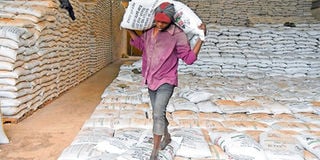Embrace prudent use of fertilisers to raise yields

A man carries a bag of fertiliser at an NCPB store. Good fertiliser should contain all registered nutrients with every granule containing the correct ratio of essential nutrients, which reduces the risk of yield loss. FILE PHOTO | NMG
What you need to know:
- Dwindling supplies of even basic produce like maize is a case in point. The situation is compounded by the dismal uptake of fertiliser, which farmers bet on to boost nutrients and spur growth as rains fail.
- Such low uptake interferes with nutrients balance in production systems. Soil as a medium through which farmers grow crops has numerous nutrients.
- Fertiliser replaces nutrients removed from the soil during harvest. It allows soils to maintain or increase plant growth by providing essential nutrients throughout its life cycle.
- In fertiliser application, more does not mean better. The idea is to use the right source, at the right rate, right time and right place.
As soils in Kenya move from poor to chronic conditions as a result of nutrient deficiency because of years of overuse, the impact on yields and food security is dire.
In breadbasket regions, the dip in harvests has raised concerns as tens of thousands of farmers increasingly find themselves without income.
Dwindling supplies of even basic produce like maize is a case in point. The situation is compounded by the dismal uptake of fertiliser, which farmers bet on to boost nutrients and spur growth as rains fail.
More fertiliser application holds the key to enhancing agricultural productivity.
The national average fertiliser use is less than 10kgs per acre, compared to the 75kgs recommended.
Such low uptake interferes with nutrients balance in production systems. Soil as a medium through which farmers grow crops has numerous nutrients. When these are unavailable or in short supply, it hampers plant growth.
With low nutrient levels, plants cannot function well and food production is hampered.
Upon harvesting, the natural supply of nutrients in the soil dwindles. A common question asked by smallholder farmers is, ‘Why do we need to use fertiliser?’
Fertiliser replaces nutrients removed from the soil during harvest. It allows soils to maintain or increase plant growth by providing essential nutrients throughout its life cycle.
Since the 1960s, global food production has more than doubled as farmers embrace fertiliser. It is estimated that up to half of the global food supply is directly connected to the use of commercial fertiliser. To meet future food demands, the world must double its production levels.
While fertiliser remains crucial, crop producers must be careful about how they apply it. Too little or the wrong compounds would mean crops will not produce much and too much would pollute the environment.
The concept of the 4R Nutrient Stewardship that has been championed by the global industry comes in handy. It advocates for matching nutrient supply with crop requirements in fertiliser use to reduce nutrient losses.
In fertiliser application, more does not mean better. The idea is to use the right source, at the right rate, right time and right place.
A good fertiliser should contain all registered nutrients with every granule containing the correct ratio of essential nutrients, which reduces the risk of yield loss.
Mr Maina is the marketing and communications manager at Elgon Kenya.





